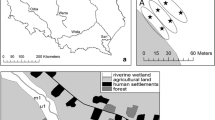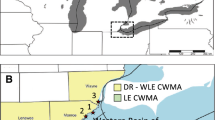Abstract
Invasion of Phragmites australis (common reed) in wetlands throughout North America, and particularly the Laurentian Great Lakes Basin, poses significant ecological problems. The extended period of low Great Lakes water levels from 2000 to 2013 created conditions for large expansions of Phragmites in the Great Lakes coastal zone. The following extended period of high water in the Great Lakes during late 2010’s, culminating in record high lake levels in 2020 allowed managers to take advantage of high water by using a cut-to-drown management strategy (i.e., cutting plants below the water surface to stop the flow of atmospheric gases) to control Phragmites populations. To examine the efficacy of a cut-to-drown control strategy, we conducted a controlled-greenhouse study that tested the effect of submergence and timing of cutting (early or late in growing season) on Phragmites growth and viability post treatment. To evaluate Phragmites growth and viability, we measured belowground biomass, rhizome non-structural carbohydrate content (NSC), and rhizome viability following a cut-to-drown treatment. Applying a cut-to-drown treatment reduced average belowground biomass production up to 99%, limited rhizome NSC content up to 83%, and inhibited rhizome viability, regardless of timing of cutting treatments. These results suggest that under high-water conditions, utilizing a cut-to-drown strategy has potential for being a useful control mechanism for Phragmites. However, further research is needed to determine to what extent these results will lead to sustained reductions in growth and viability under field conditions, where rhizome belowground biomass and storage capacity are much larger.




Similar content being viewed by others
References
Armstrong J, Armstrong W (1991) A convective through-flow of gases in Phragmites australis (Cav.) Trin. Ex Steud. Aquat Bot 39:75–88. https://doi.org/10.1016/0304-3770(91)90023-X
Armstrong J, Armstrong W, Beckett PM (1992) Phragmites australis: Venturi- and humidity‐induced pressure flows enhance rhizome aeration and rhizosphere oxidation. New Phytol 120:197–207. https://doi.org/10.1111/j.1469-8137.1992.tb05655.x
Asaeda T, Rajapakse L, Manatunge J, Sahara N (2006) The effect of summer harvesting of Phragmites australis on growth characteristics and rhizome resource storage. Hydrobiologia 553:327–335. https://doi.org/10.1007/s10750-005-1157-6
Bart D, Hartman JM (2000) Environmental determinants of Phragmites australis expansion in a New Jersey salt marsh: an experimental approach. Oikos 89:59–69. https://doi.org/10.1034/j.1600-0706.2000.890107.x
Bart D, Burdick D, Chambers R, Hartman JM (2006) Human facilitation of Phragmites australis invasions in tidal marshes: a review and synthesis. Wetl Ecol Manag 14:53–65. https://doi.org/10.1007/s11273-005-2566-z
Bourgeau-Chavez LL, Kowalski KP, Carlson Mazur ML et al (2013) Mapping invasive Phragmites australis in the coastal great lakes with ALOS PALSAR satellite imagery for decision support. J Great Lakes Res 39:65–77. https://doi.org/10.1016/j.jglr.2012.11.001
Brix H, Sorrell BK, Schierup HH (1996) Gas fluxes achieved by in situ convective flow in Phragmites australis. Aquat Bot 54:151–163. https://doi.org/10.1016/0304-3770(96)01042-X
Chambers RM, Meyerson LA, Saltonstall K (1999) Expansion of Phragmites australis into tidal wetlands of North America. Aquat Bot 64:261–273. https://doi.org/10.1016/S0304-3770(99)00055-8
Čížková H, Lukavská J, Přibáň K et al (1996) Carbohydrate levels in rhizomes of Phragmites australis at an oligotrophic and a eutrophic site: a preliminary study. Folia Geobot 31:111–118. https://doi.org/10.1007/bf02804000
Clevering OA, Lissner J (1999) Taxonomy, chromosome numbers, clonal diversity and population dynamics of Phragmites australis. Aquat Bot 64:185–208. https://doi.org/10.1016/S0304-3770(99)00059-5
Colmer TD, Pedersen O (2008) Underwater photosynthesis and respiration in leaves of submerged wetland plants: gas films improve CO2 and O2 exchange. New Phytol 177:918–926. https://doi.org/10.1111/j.1469-8137.2007.02318.x
Colmer TD, Winkel A, Pedersen O (2011) A perspective on underwater photosynthesis in submerged terrestrial wetland plants. AoB Plants 2011:plr030. https://doi.org/10.1093/aobpla/plr030
Cronin JT, Johnston J, Diaz R (2020) Multiple potential stressors and dieback of Phragmites australis in the Mississippi River Delta, USA: implications for restoration. Wetlands 40:2247–2261. https://doi.org/10.1007/s13157-020-01356-8
Dinka M, Szeglet P (1999) Carbohydrate and nutrient content in rhizomes of Phragmites australis from different habitats of Lake Ferto/Neusiedlersee. Limnologica 29:47–59. https://doi.org/10.1016/S0075-9511(99)80038-3
Engloner AI (2009) Structure, growth dynamics and biomass of reed (Phragmites australis) - a review. Flora 204:331–346. https://doi.org/10.1016/j.flora.2008.05.001
Fell PE, Warren RS, Light JK et al (2003) Comparison of fish and macroinvertebrate use of Typha angustifolia, Phragmites australis, and treated Phragmites marshes along the lower Connecticut River. Estuaries 26:534–551. https://doi.org/10.1007/BF02823729
Granéli W, Weisner SEB, Sytsma MD (1992) Rhizome dynamics and resource storage in Phragmites australis. Wetl Ecol Manag 1:239–247. https://doi.org/10.1007/BF00244929
Gronewold AD, Rood RB (2019) Recent water level changes across earth’s largest lake system and implications for future variability. J Great Lakes Res 45:1–3. https://doi.org/10.1016/j.jglr.2018.10.012
Hazelton ELG, Mozdzer TJ, Burdick DM et al (2014) Phragmites australis management in the United States: 40 years of methods and outcomes. AoB Plants 6:1–19. https://doi.org/10.1093/aobpla/plu001
Hellings SE, Gallagher JL (1992) The Effects of salinity and flooding on Phragmites australis. J Appl Ecol 29:41. https://doi.org/10.2307/2404345
Jackson MB (1985) Ethylene and responses of plants to soil waterlogging and submergence. Annu Rev Plant Physiol 36:145–174. https://doi.org/10.1146/annurev.pp.36.060185.001045
Juneau KJ, Tarasoff CS (2013) The seasonality of survival and subsequent growth of common reed (Phragmites australis) rhizome fragments. Invasive Plant Sci Manag 6:79–86. https://doi.org/10.1614/ipsm-d-12-00051.1
Karunaratne S, Asaeda T, Yutani K (2004) Shoot regrowth and age-specific rhizome storage dynamics of Phragmites australis subjected to summer harvesting. Ecol Eng 22:99–111. https://doi.org/10.1016/j.ecoleng.2004.02.006
Kassambara A (2021) rstatix: Pipe-Friendly Framework for Basic Statistical Tests. R package version 0.7.2. https://rpkgs.datanovia.com/rstatix/
Kayastha MB, Ye X, Huang C, Xue P (2022) Future rise of the great lakes water levels under climate change. J Hydrol 612:128205. https://doi.org/10.1016/j.jhydrol.2022.128205
Keller BEM, Massachusetts USA (2000) Plant diversity in Lythrum, Phragmites, and Typha marshes. Wetl Ecol Manag 8:391–401. https://doi.org/10.1023/A:1026505817409
Landhäusser SM, Chow PS, Turin Dickman L et al (2018) Standardized protocols and procedures can precisely and accurately quantify non-structural carbohydrates. Tree Physiol 38:1764–1778. https://doi.org/10.1093/treephys/tpy118
Lenth RV (2021) Emmeans: estimated marginal means. aka Least-Squares Means. R package version 1.8.4-1. https://CRAN.R-project.org/package=emmeans
Lombard KB, Tomassi D, Ebersole J (2012) Long-term management of an invasive plant: lessons from seven years of Phragmites australis Control. Northeast Nat 19(6):181–193
Marks M, Lapin B, Randall J (1994) Phragmites australis (P. communis): threats, management and monitoring. Nat Areas J 14:285–294
Martin LJ, Blossey B (2013) The runaway weed: costs and failures of Phragmites australis Management in the USA. Estuar Coasts 36:626–632. https://doi.org/10.1007/s12237-013-9593-4
Masuko T, Minami A, Iwasaki N et al (2005) Carbohydrate analysis by a phenol-sulfuric acid method in microplate format. Anal Biochem 339:69–72. https://doi.org/10.1016/j.ab.2004.12.001
Mauchamp A, Blanch S, Grillas P (2001) Effects of submergence on the growth of Phragmites australis seedlings. Aquat Bot 69:147–164. https://doi.org/10.1016/S0304-3770(01)00135-8
MDNR (2014) A guide to control and management of Invasive Phragmites. Third Edition. Michigan Department of Natural Resources. https://www.michigan.gov/-/media/Project/Websites/invasives/Documents/Response/Status/egle-ais-guide-phragmites.pdf
Meyerson LA, Saltonstall K, Windham L et al (2000) A comparison of Phragmites australis in freshwater and brackish marsh environments in North America. Wetl Ecol Manag 8:89–103. https://doi.org/10.1023/a:1008432200133
Moore GE, Burdick DM, Peter CR, Keirstead DR (2012) Belowground biomass of Phragmites australis in coastal marshes. Northeast Nat 19:611–626. https://doi.org/10.1656/045.019.0406
Nichols G (2020) Invasive Phragmites (Phragmites australis). Best management practices in Ontario: improving species at risk habitat through the management of Invasive Phragmites. Edition 2.1. Ontario Invasive Plant Council, Petersborough, ON. https://www.ontarioinvasiveplants.ca/wp-content/uploads/2021/05/OIPC_BMP_Phragmites_April302021_D10_WEB.pdf
NOAA (2021) Water level dashboard. https://doi.org/https://www.glerl.noaa.gov/data/dashboard/GLD_HTML5.html
Ostendorp W (1991) Damage by episodic flooding to Phragmites reeds in a prealpine lake: proposal of a model. Oecologia 86:119–124. https://doi.org/10.1007/BF00317398
R Core Development Team (2021) A language and environment for statistical computing. R Foundation for Statistical Computing, Indianapolis
Saltonstall K (2002) Cryptic invasion by a non-native genotype of the common reed, Phragmites australis, into North America. Proc Natl Acad Sci USA 99:2445–2449. https://doi.org/10.1073/pnas.032477999
Saltonstall K (2003) Genetic variation among north american populations of Phragmites australis: implications for management. Estuaries 26:444–451. https://doi.org/10.1007/BF02823721
Seglenieks F, Temgoua A (2022) Future water levels of the great lakes under 1.5°C to 3°C warmer climates. J Great Lakes Res 48:865–875. https://doi.org/10.1016/j.jglr.2022.05.012
Sesin V, Davy CM, Stevens KJ et al (2021) Glyphosate toxicity to native Nontarget Macrophytes following three different routes of incidental exposure. Integr Environ Assess Manag 17:597–613. https://doi.org/10.1002/ieam.4350
Tshapa L, Naidoo K, Naidoo G (2021) Morphological and physiological responses of Arundo donax and Phragmites australis to waterlogging stress. Flora 279:151816. https://doi.org/10.1016/j.flora.2021.151816
Tulbure MG, Johnston CA (2010) Environmental conditions promoting non-native Phragmites australis expansion in Great Lakes Coastal Wetlands. Wetlands 30:577–587. https://doi.org/10.1007/s13157-010-0054-6
Tulbure MG, Johnston CA, Auger DL (2007) Rapid invasion of a Great Lakes coastal wetland by non-native Phragmites australis and Typha. J Gt Lakes Res 33:269–279
VanDeWeghe A, Lin V, Jayaram J, Gronewold AD (2022) Changes in large lake water level dynamics in response to climate change. Front Water. https://doi.org/10.3389/frwa.2022.805143
Vyn R (2021) Preliminary cost-benefit analysis for prevention, treatment and control of Phragmites in Ontario. Green Shovel Collaborative. https://www.greenshovels.ca/wp-content/uploads/2021/08/Ontario-Phragmites-Cost-Benefit-Analysis_DRAFT_Public-Review_WEB.pdf
Weisner SEB, Strand JA (1996) Rhizome architecture in Phragmites australis in relation to water depth: implications for within-plant oxygen transport distances. Folia Geobot 31:91–97. https://doi.org/10.1007/bf02803998
Wen B, Li X, Yang F et al (2017) Growth and physiology responses of Phragmites australis to combined drought-flooding condition in inland saline-alkaline marsh, Northeast China. Ecol Eng 108:234–239. https://doi.org/10.1016/j.ecoleng.2017.08.036
Whyte RS, Trexel-Kroll D, Klarer DM et al (2008) The invasion and spread of Phragmites australis during a period of low water in a lake Erie Coastal Wetland. J Coast Res. https://doi.org/10.2112/SI55-19.1
Wickham H (2016) ggplot2: elegant graphics for data analysis. Springer, New York
Wilcox DA (2012) Response of wetland vegetation to the post-1986 decrease in Lake St. Clair water levels: seed-bank emergence and beginnings of the Phragmites australis invasion. J Great Lakes Res 38:270–277. https://doi.org/10.1016/j.jglr.2012.02.007
Winkel A, Visser EJW, Colmer TD et al (2016) Leaf gas films, underwater photosynthesis and plant species distributions in a flood gradient. Plant Cell Environ 39:1537–1548. https://doi.org/10.1111/pce.12717
Wuebbles D, Cardinale B, Cherkauer K et al (2019) An Assessment of the impacts of climate change on the Great Lakes. Environmental Law and Policy Center. https://elpc.org/wp-content/uploads/2020/04/2019-ELPCPublication-Great-Lakes-Climate-Change-Report.pdf
Acknowledgements
We thank Theresa Gruninger, Alexandra “Sasha” Bozimowski, and Annie Bonds for their tireless efforts in monitoring and harvesting all 162 plants. Additionally, we thank the Ypsilanti Township Recreation and Parks Commission in Michigan for allowing us to collect our plants at North Hydro Park and the University of Michigan Matthaei Botanical Gardens for allowing us to conduct our experiment at their greenhouse facility. We thank Janice Gilbert for providing an early review of this manuscript. Lastly, we thank Michelle Vander Haar of the U.S. Fish and Wildlife Service (USFWS) for development, conceptualization, and continued project participation through our USFWS/USGS Science Support Partnership (Project number: 2021-R3-09), without which this work would not have been possible. Any use of trade, product, or firm names is for descriptive purposes only and does not imply endorsement by the U.S. Government.
Funding
This study was funded by the U.S. Geological Survey and The U.S. Fish and Wildlife Service Science Support Partnership Project number: 2021-R3-09.
Author information
Authors and Affiliations
Contributions
WAB, SLW, and KPK designed the experiment. SLW and WAB set up and carried out up the experiment. SLW and WAB collected the data. SLW and WAB analyzed the data and prepared the figures. SLW wrote the main manuscript text. WAB and KPK procured the funding and edited the text. All authors reviewed the manuscript.
Corresponding author
Ethics declarations
Competing interests
The authors declare no competing interests.
Additional information
Publisher’s Note
Springer Nature remains neutral with regard to jurisdictional claims in published maps and institutional affiliations.
Rights and permissions
About this article
Cite this article
Widin, S.L., Bickford, W.A. & Kowalski, K.P. Phragmites management in high water: cutting plants under water limits biomass production, carbohydrate storage, and rhizome viability. Wetlands Ecol Manage 31, 745–756 (2023). https://doi.org/10.1007/s11273-023-09946-z
Received:
Accepted:
Published:
Issue Date:
DOI: https://doi.org/10.1007/s11273-023-09946-z




